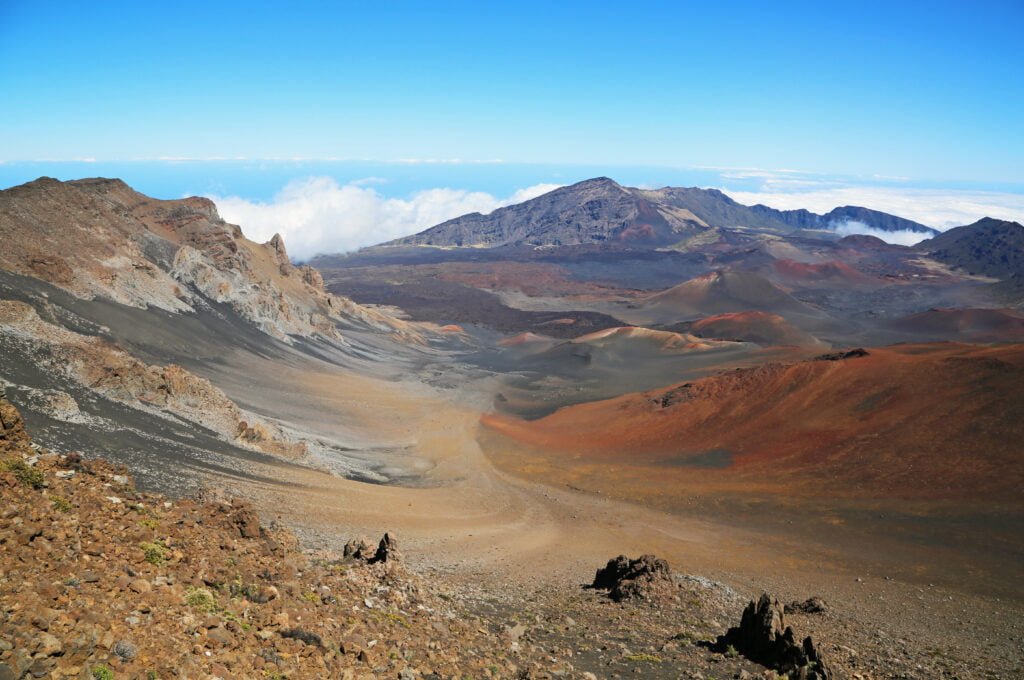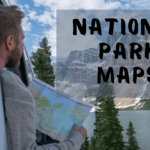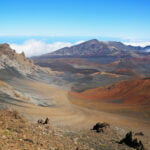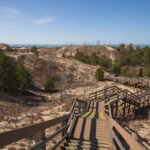Haleakalā National Park
Welcome to Haleakalā National Park on the island of Maui, a stunning expanse covering 33,265 acres of everything from tranquil beaches to dramatic volcanic scenery. At the heart of the park is the dormant Haleakalā Volcano, standing tall at 10,023 feet, known as the “House of the Sun” in Hawaiian. The park’s goal is to conserve these diverse and delicate ecosystems and honor the cultural legacy of Hawaii’s indigenous peoples.
The park offers visitors a wealth of unforgettable moments, such as the famous Haleakalā sunrise, exploring the verdant Kīpahulu District, and hiking the stark, volcanic terrain of the Summit District. It’s also a sanctuary for rare and unique species like the endangered nēnē (Hawaiian goose) and the iconic silversword plant, among over 900 native plant species. With its archaeological sites, Haleakalā National Park offers a glimpse into the lives of the Hawaiian people who have called this place home for centuries.
Haleakalā stands out for its incredible variety of landscapes, from desert to rainforest, and its deep cultural connections. As you explore this captivating park, you’ll be amazed by its breathtaking vistas, diverse wildlife, and profound cultural stories.
Location of Haleakalā National Park
Haleakalā National Park is a stunning and diverse expanse located on the island of Maui, one of the eight main islands that make up the Hawaiian archipelago in the United States. The park covers an area of approximately 33,265 acres, stretching across various habitats, from the summit of Haleakalā volcano to the lush Kīpahulu coastal region. Its unique geographical setting, characterized by an impressive range of ecosystems and microclimates, contributes to the park’s unmatched ecological diversity and captivating beauty.
Directions to Haleakalā National Park
Haleakalā National Park is located on the island of Maui in Hawaii. To get there:
- From Kahului, HI: Take HI-37 (Hana Highway) and continue onto HI-377 (Haleakalā Highway) for approximately 37 miles to the park entrance.
For GPS navigation, use: Haleakalā National Park, Kula, HI 96790.
Coordinates of Haleakalā National Park
- Latitude: 20.7204° N
- Longitude: 156.1552° W
Scenery Haleakalā National Park
The name Haleakalā, which means “house of the sun” in the Hawaiian language, is fitting for the park’s most iconic geological feature – the dormant Haleakalā volcano. Standing at an impressive 10,023 feet above sea level, the summit of this massive shield volcano offers remarkable views of the surrounding landscape. The park also boasts the world’s largest dormant volcanic crater, which spans around 7.5 miles in length, 2.5 miles in width, and 3,000 feet in depth. This colossal geological marvel, together with the surrounding cinder cones and lava flows, is a testament to the island’s volcanic origins.
The park’s location and diverse topography give rise to various microclimates and habitats, including subalpine shrublands, montane bogs, and tropical rainforests, which are home to numerous native and endangered species. The park’s ecological diversity and the presence of rare endemic species, such as the Haleakalā silversword and the Hawaiian petrel, make it an invaluable natural sanctuary. Additionally, the historical significance of the park is evidenced by over 200 ancient Hawaiian archaeological sites found within its boundaries.
Haleakalā National Park’s unique location and geological features provide visitors with unparalleled recreational opportunities. From enjoying the mesmerizing sunrise at the summit, to hiking through the verdant bamboo forests, to exploring the black sand beaches and freshwater pools of the Kīpahulu coastal region, the park offers countless ways to connect with nature and immerse oneself in the breathtaking beauty of this island paradise.
Haleakalā National Park Opening Times
Haleakalā National Park, located on the island of Maui in Hawai’i, is a majestic destination that encompasses diverse landscapes and offers breathtaking experiences for its visitors. The park is open year-round, 24 hours a day, seven days a week, making it an ideal destination regardless of the season. However, it’s important to note that certain areas within the park may have specific hours, and some facilities and visitor centers operate on a limited schedule.
For instance, the park’s two visitor centers, the Haleakalā Visitor Center and the Kīpahulu Visitor Center, are open daily but have varying hours. Typically, they open between 8:00 am and 3:45 pm, but it’s always a good idea to check the park’s website for the most up-to-date information.
The park’s hours and closures can be influenced by several factors, such as weather conditions and wildlife protection. Seasonal variations in weather can impact road conditions, making it essential to plan your visit accordingly. Additionally, certain areas may be temporarily closed to protect nesting birds or other wildlife species.
When planning your visit to Haleakalā National Park, it’s essential to be aware of the park’s hours, weather conditions, and any seasonal variations to make the most of your experience. Always check the park’s website for the most current information on opening times and possible closures, ensuring a memorable and safe adventure in this extraordinary national park.
Visitor Centers and Facilities at Haleakalā National Park
Haleakalā National Park, located on the beautiful island of Maui, Hawaii, offers visitors an array of facilities designed to enrich their experience while exploring this unique and diverse landscape. There are two main visitor centers within the park, found at the Kīpahulu and Haleakalā Summit districts.
The Haleakalā Visitor Center, situated at the summit, is perched at an elevation of 9,740 feet. This center is where you will find valuable information services, including park maps, trail guides, and knowledgeable rangers who can assist you in planning your visit. The center features educational exhibits, restrooms, and a small bookstore to help you learn more about the area’s fascinating cultural and natural history. No picnic areas or playgrounds are available at this location, but you can find breathtaking views and excellent opportunities for stargazing and witnessing the famous Haleakalā sunrise.
In the Kīpahulu District, the Kīpahulu Visitor Center offers similar amenities, including restrooms, information services, and exhibits focused on the region’s cultural and natural resources. This center is also a great starting point for exploring the lush bamboo forests, waterfalls, and coastal areas of the park. A picnic area is available nearby, making it an ideal spot for enjoying a meal amidst scenic surroundings.
To make the most of your visit to these facilities, it is recommended that you arrive early, as parking can be limited, especially during peak seasons and sunrise hours. Be sure to check the park’s official website for visitor center operating hours, as they may vary throughout the year. It’s also important to remember that the high altitude at the summit can lead to cooler temperatures and possible altitude sickness, so be prepared with appropriate clothing and take your time while exploring this remarkable national park.
Accessibility at Haleakalā National Park
Haleakalā National Park is dedicated to ensuring an enjoyable and accessible experience for all visitors, including those with disabilities or mobility challenges. The park offers several accessible facilities and features to accommodate diverse needs. The Haleakalā Visitor Center, located at 9,740 feet, and the Headquarters Visitor Center, situated at 7,000 feet, both provide accessible parking, restrooms, and exhibit areas.
For visitors seeking an outdoor experience, the park boasts a range of accessible trails and viewpoints. The Haleakalā overlook, adjacent to the Haleakalā Visitor Center, offers stunning views with wheelchair-accessible ramps. The short and paved Pa Kaoao Trail, near the same visitor center, is another wheelchair-friendly option with panoramic views of the crater. The Hosmer Grove Nature Loop, a partially accessible trail, immerses visitors in a unique forest habitat.
For a more extensive adventure, the Sliding Sands Trail, though not fully accessible, features a hardened surface with a gentle grade at its beginning, suitable for visitors with limited mobility or using assisted devices.
Despite these accessible features, some areas of the park may present challenges for visitors with accessibility needs. The park’s high elevation and rough, rocky terrain could make certain trails difficult to navigate. It is recommended to check with park rangers for specific information and guidance on suitable activities based on individual needs and abilities.
Getting To Haleakalā National Park
Getting to Haleakalā National Park is an exciting journey through Maui’s breathtaking landscapes. The park is located on the island of Maui, which can be accessed via Kahului Airport (OGG), the island’s primary airport. From here, you have several options for reaching the park.
The most popular way to get to Haleakalā National Park is by renting a car and driving. The drive from Kahului Airport takes approximately 1.5-2 hours, depending on traffic and weather conditions. As you ascend the winding Haleakalā Highway (Route 37) and Crater Road (Route 378), you’ll be treated to mesmerizing views of Maui’s diverse landscapes.
Alternatively, you can join a guided tour or shuttle service to the park. Many tour operators on Maui offer day trips and sunrise excursions to Haleakalā National Park, which typically include transportation, park admission, and a knowledgeable guide.
There is no public transportation directly to the park, so renting a car or booking a guided tour is the best option.
When it comes to parking, the park has limited spaces available at its two main visitor centers: Haleakalā Visitor Center and Kīpahulu Visitor Center. Parking fees are included in the park entrance fee. During peak times, such as sunrise or holidays, parking can be challenging, and visitors are advised to arrive early to secure a spot. If you’re visiting for sunrise, note that reservations are required in addition to the park entrance fee. The reservation system helps manage the number of visitors and alleviate parking congestion during these popular hours.
Haleakalā National Park Entrance Fees and Passes
Welcome to Haleakalā National Park, a spectacular destination where you will experience diverse landscapes, from the summit of Haleakalā to the lush Kīpahulu coastal area. Before embarking on your adventure, it’s essential to be aware of the entrance fees, permits, and reservations necessary for a smooth visit.
Upon arrival, visitors are required to pay an entrance fee. For vehicles, the fee is $30, and for motorcycles, it’s $25. These entry passes are valid for three days. Individuals entering by foot or bicycle must pay $15 per person.
For frequent visitors, the Haleakalā National Park Annual Pass, priced at $50, grants unlimited entry for one year from the purchase date. However, this pass covers only the pass holder and their immediate family or passengers in a private, non-commercial vehicle.
Senior citizens (62 years and older) may be eligible for a Lifetime Senior Pass that costs $80 or an Annual Senior Pass for $20. There are also Access Passes available free of charge for U.S. citizens with permanent disabilities. Additionally, active military members can obtain a free Annual Military Pass.
All fees contribute to the park’s maintenance, wildlife protection, and visitor services. By purchasing a pass, you are supporting the preservation of Haleakalā National Park for future generations.
Certain park activities, such as backcountry camping and cabin stays, require additional permits and reservations. These can be obtained online or at the visitor centers. It’s important to plan ahead and secure any necessary permits to ensure a hassle-free visit.
Before exploring the natural beauty of Haleakalā National Park, make sure to have your pass, permits, and reservations in order. By doing so, you’ll be all set to fully immerse yourself in the unique wonders this park has to offer.
Haleakalā National Park Park Rules and Regulations
At Haleakalā National Park, it is crucial for visitors to follow park rules and regulations designed to protect the park’s unique environment, ensure the safety of visitors and wildlife, and maintain the natural beauty of the area. Responsible behavior not only enhances your visit but also helps preserve the park for future generations.
One common regulation is to stay on designated trails at all times, which helps prevent erosion, protect fragile ecosystems, and avoid disrupting wildlife habitats. Visitors must not feed or approach wildlife, as this can lead to aggressive behavior and endanger both humans and animals. Always properly store and dispose of food and litter, as even small amounts of trash can have a significant impact on the park’s ecosystem.
Additionally, camping is only permitted in designated areas, and campfires are prohibited to prevent wildfires. If you plan to camp, make sure to obtain a permit in advance and adhere to the park’s Leave No Trace principles.
Cultural sites hold great significance to the native Hawaiian people, so it’s essential to show respect and avoid touching or disturbing these areas. Drones are also prohibited to maintain a peaceful atmosphere and protect the privacy of other visitors.
Visitors who violate park rules and regulations may face fines or expulsion from the park. By following these guidelines and practicing responsible behavior, you can play a vital role in conserving the beauty and wonder of Haleakalā National Park for generations to come.
Transportation Within Haleakalā National Park
Haleakalā National Park offers several transportation options for all types of visitors, with each offering unique advantages and limitations. For those who prefer to explore the park independently, personal vehicles are the most popular choice. This allows maximum flexibility to visit various sites at your own pace, but keep in mind that parking is limited during peak seasons.
Alternatively, guided tours operated by authorized companies provide a more structured experience, with expert guides sharing insights about the park’s history, geology, and wildlife. This option is more sustainable, as it reduces the number of vehicles entering the park and helps prevent overcrowding.
Cycling enthusiasts can rent bikes and enjoy the scenic, winding roads leading to the summit of Haleakalā. This eco-friendly mode of transport is not only a great way to stay active, but also allows you to take in the park’s breathtaking landscapes at a leisurely pace. Note that cycling within the park requires a high level of fitness and experience, as the terrain can be challenging.
Lastly, for visitors with limited mobility, there are accessible trails and overlooks throughout the park. While public transportation is not available within Haleakalā National Park, shuttle services can be arranged through private tour operators to accommodate specific needs.
In choosing the best mode of transport, consider factors such as accessibility, sustainability, and convenience. For example, families with young children may prefer a guided tour, while solo adventurers might opt for a bike ride or a personal vehicle. Popular routes within the park include the Road to Haleakalā summit, the Keonehe’ehe’e (Sliding Sands) Trail, and the Pīpīwai Trail.
Haleakalā National Park Attractions
1. Haleakalā Summit
Perched at over 10,000 feet above sea level, the Haleakalā Summit is an awe-inspiring location with panoramic views of the surrounding landscape. The summit’s otherworldly terrain and vibrant colors make it a must-visit spot. The best time to visit is during sunrise or sunset, as the sun’s rays cast stunning hues over the volcanic landscape. Keep in mind that temperatures can be chilly at this altitude, so dress accordingly.
2. Sliding Sands Trail
Sliding Sands Trail is a fascinating journey through the heart of Haleakalā’s volcanic landscape. As you descend into the park’s crater, you’ll encounter cinder cones and vibrant colors that are truly out of this world. The trail is best experienced in the early morning or late afternoon, as temperatures can be extreme during midday. This challenging hike requires proper preparation, including plenty of water and sturdy footwear.
3. Hosmer Grove
A lush, green oasis, Hosmer Grove is a serene contrast to the stark volcanic landscape. This area features a diverse range of native and non-native plant life, and several trails wind through the grove, offering glimpses of rare bird species. The best time to visit Hosmer Grove is in the early morning, when the birds are most active. Keep in mind that the area is often damp, so dress appropriately.
4. Kīpahulu District
Located on the park’s lush eastern side, the Kīpahulu District is home to the famous Pools of Oheo, a series of pristine freshwater pools fed by cascading waterfalls. The area is perfect for a refreshing dip, and the nearby Pipiwai Trail offers a scenic hike to the 400-foot Waimoku Falls. The best time to visit is in the morning or early afternoon when the sun is shining, but be aware that flash flooding can occur, closing access to the pools.
5. Leleiwi Overlook
This easily accessible lookout point offers a stunning view of the Haleakalā Crater. The Leleiwi Overlook sits at an elevation of 8,840 feet, allowing visitors to take in the vast expanse of the volcanic landscape. The best time to visit is during sunrise or sunset, when the light adds an ethereal quality to the scenery. The temperature can drop quickly at this elevation, so layered clothing is recommended.
One of my favorite memories of visiting Haleakalā National Park was watching the sunrise from the summit. The brilliant colors reflecting off the crater’s surface were unlike anything I had ever seen, making the early wake-up call and chilly temperatures entirely worth it.
Recreational Activities at Haleakalā National Park
Best Times to Visit Haleakalā National Park
Haleakalā National Park, located on the island of Maui in Hawaii, offers visitors a unique opportunity to explore diverse ecosystems, witness breathtaking sunrises and sunsets, and encounter endemic wildlife. The park is open year-round, but the best time to visit depends on your preferences and priorities.
The climate in Haleakalā is generally mild throughout the year, with temperatures ranging from 30°F to 80°F. However, due to its elevation, the summit area can be quite chilly, particularly at sunrise and sunset. If you prefer warmer temperatures, visit during the summer months of June through August, when daytime highs average around 70°F. However, be prepared for larger crowds during this peak season.
Spring (March through May) and fall (September through November) are also excellent times to visit, as temperatures remain pleasant though slightly cooler than summer, and visitor numbers tend to be lower. These shoulder seasons also offer the benefit of fewer rain showers, which can sometimes interfere with outdoor activities.
For those looking to avoid crowds, the winter months of December through February can be an ideal time to visit. Although temperatures at the summit can drop below freezing, the park remains open and accessible. You may also have a better chance of spotting the park’s endangered nēnē (Hawaiian goose) during this time, as they are more active in the colder months. However, some facilities and services may have reduced hours or be closed during the winter months, so be sure to check the park’s website for updated information.
In summary, the best time to visit Haleakalā National Park will depend on your preferences and priorities. If you prioritize warmer temperatures and don’t mind the crowds, summer is your best bet. For a balance of pleasant weather and lower visitor numbers, consider visiting in the spring or fall. If wildlife sightings and fewer crowds are your main priorities, winter can be a rewarding time to explore the park. No matter when you choose to visit, Haleakalā’s awe-inspiring beauty is sure to leave a lasting impression.
Nearby Attractions to Haleakalā National Park
Haleakalā National Park, located on the island of Maui in Hawai’i, offers visitors a plethora of outdoor activities and breathtaking natural beauty. Although the park itself offers an unforgettable experience, the surrounding area boasts a variety of attractions well worth exploring. Here are three nearby attractions to consider incorporating into your Haleakalā National Park visit:
1. Upcountry Maui: Just a short drive from the park, Upcountry Maui offers a different perspective of the island, characterized by rolling hills, vibrant flora, and cooler temperatures. This area is home to several farms, botanical gardens, and the Ali’i Kula Lavender farm, providing visitors with a unique and serene experience. Be sure to carve out some time to explore charming small towns, such as Makawao and Kula, where you can indulge in local foods and crafts.
2. Road to Hāna: Considered one of the most scenic drives in the world, the Road to Hāna is a 64.4-mile-long stretch from Kahului to the town of Hāna, offering striking views of lush landscapes, waterfalls, and the ocean. While the journey can take a full day, the unspoiled beauty and numerous points of interest along the way make it a worthwhile adventure. Plan ahead for this excursion, as it requires a full day of driving and exploring.
3. Iao Valley State Park: Located approximately 36 miles from Haleakalā National Park, Iao Valley State Park is a lush, green oasis featuring the iconic Iao Needle, a 1,200-foot tall lava remnant. The park offers hiking trails, historical sites, and picturesque views of the valley. This is an ideal destination for those looking to immerse themselves in Hawai’i’s rich history and natural beauty.
While these attractions offer unique experiences and a chance to explore different aspects of Maui, they do require additional time and planning. Be sure to consider your schedule and personal interests when deciding whether to include these attractions in your Haleakalā National Park visit. Each location may have specific hours of operation and potential fees, so research ahead to ensure a smooth and enjoyable experience.
Tips for Visiting Haleakalā National Park
When planning a visit to the stunning Haleakalā National Park, it’s essential to consider the best time to visit, what to pack, and necessary safety precautions to ensure a memorable and enjoyable experience.
The optimal time to visit the park varies based on your interests. For those looking to witness the famous Haleakalā sunrise, it’s best to visit during the winter months when the park is less crowded. However, keep in mind that this is also the time when temperatures are at their lowest, so dress accordingly. If hiking and exploring the park’s diverse landscapes are your priority, spring and fall offer more stable weather conditions, which are ideal for outdoor activities.
Packing for your trip to Haleakalā National Park should include layers of clothing, as the weather can be unpredictable, with temperature changes from day to night. Don’t forget comfortable hiking shoes, a hat, sunglasses, sunscreen, and plenty of water. For photography enthusiasts, a tripod is essential for capturing the perfect sunrise or sunset shot, along with extra batteries and memory cards.
When visiting Haleakalā, safety should be a top priority. Stay on designated trails to avoid potential hazards like loose rocks and steep cliffs. Be mindful of altitude sickness, as the summit reaches over 10,000 feet. Take your time to acclimate, and don’t overexert yourself. Wildlife encounters can occur, so maintain a respectful distance and never feed the animals.
Recommended itineraries depend on your interests and level of experience. For a day trip, start with a sunrise at the summit, followed by a moderate hike on the Sliding Sands Trail, then explore the Hosmer Grove area, which is home to native and endangered bird species. For a more extended visit, consider a multi-day backpacking trip through the park’s wilderness, exploring unforgettable landscapes like the Kaupo Gap and Kīpahulu Valley.
With careful planning and consideration, a visit to Haleakalā National Park can be an unforgettable experience that caters to visitors of all interests and levels of experience.
Camping and Lodging at Haleakalā National Park
Haleakalā National Park, located on the beautiful island of Maui, offers a variety of accommodation and lodging options, catering to the diverse needs and budgets of its visitors. From rustic camping experiences to luxurious stays at nearby hotels, there’s something for everyone at this picturesque destination.
For those seeking an immersive experience within the park itself, there are two drive-up campgrounds – Hosmer Grove and Kīpahulu. Hosmer Grove, near the summit, offers cooler temperatures and is perfect for stargazing, while Kīpahulu offers oceanfront camping and access to the famous Pools of Ohe’o. Both campgrounds operate on a first-come, first-served basis and charge a nominal fee. Remember to bring your camping gear and be prepared for basic facilities, like pit toilets.
In addition to campgrounds, the park offers three wilderness cabins for rent within the crater, namely Holua, Kapalaoa, and Palikū. These cabins provide shelter and simple amenities, such as bunk beds, a wood-burning stove, and pit toilets. Advanced reservations are required and can be made up to six months in advance through the park’s website.
For those who prefer a more comfortable stay, the nearby town of Kula offers charming bed and breakfasts, like the Haleakalā Ranch and Kula Lodge. These establishments provide a cozier experience, with amenities like private bathrooms, Wi-Fi, and on-site dining options.
If luxury is what you’re after, the upscale resort areas of Wailea and Ka’anapali are just a short drive away. These resorts boast world-class amenities, like golf courses, spas, fine dining, and beachfront access.
In summary, the accommodation options in and around Haleakalā National Park cater to every traveler’s preferences and budget. For an immersive experience, opt for the campgrounds or wilderness cabins within the park. If comfort is key, choose a bed and breakfast in Kula, or splurge on a luxurious stay at a nearby resort. No matter your choice, the breathtaking beauty of Haleakalā awaits you.
Food and Dining Options Haleakalā National Park
Haleakalā National Park, located on the beautiful island of Maui, offers visitors a variety of dining options to suit all tastes and budgets. Although there are no restaurants within the park itself, there are plenty of alternatives for fulfilling your hunger needs.
For those who prefer to bring their own food, picnicking is a popular choice. There are several designated picnic areas throughout the park where visitors can enjoy a meal while taking in the stunning scenery. Make sure to pack your snacks, a blanket, and some reusable utensils for an eco-friendly experience.
Near the entrance of the park, in the Kula and Upcountry Maui areas, you’ll find local cafes and restaurants offering diverse culinary options, ranging from budget-friendly to fine-dining establishments. Popular choices include Kula Bistro, serving Italian cuisine, and Grandma’s Coffee House, offering a selection of sandwiches, desserts, and coffee. Local cuisine featuring Hawaiian flavors and ingredients can be found at Ulupalakua Ranch Store and Grill. Expect to pay anywhere from $10 to $50 per person, depending on the restaurant and meal choice.
For those with specific dietary preferences, such as vegetarian, vegan, or gluten-free options, it’s always a good idea to research the nearby eateries in advance or consider packing your own meals to ensure that your dietary needs are met.
With a bit of planning and a spirit of adventure, you’ll be able to enjoy a satisfying dining experience while exploring the breathtaking beauty of Haleakalā National Park.
Visitor Numebers Haleakalā National Park
Haleakalā National Park, a breathtaking destination in Maui, Hawaii, welcomes a large number of visitors every year. In recent years, the park has seen an increase in visitation, with over one million guests annually. The peak season typically occurs during the summer months and holiday periods, from June through August, and during December and January. These months experience higher visitor numbers due to school vacations and favorable weather conditions.
These fluctuations in visitation can impact the visitor experience, as higher numbers can result in congested parking lots, crowded trails, and limited access to popular sites. Additionally, an increase in visitors can put added pressure on park management and conservation efforts, as maintaining the park’s pristine natural and cultural resources becomes more challenging.
To make the most of your visit to Haleakalā National Park, consider visiting during the shoulder seasons (April-May and September-October), when visitor numbers are generally lower, providing a more peaceful and enjoyable experience. Those planning a visit during peak season can still make the most of their trip by arriving early in the morning, exploring less frequented trails, and staying in the park after sunset to enjoy the unique stargazing opportunities. Regardless of visitor numbers, Haleakalā National Park offers a myriad of unforgettable experiences and is a must-visit destination for nature enthusiasts.
History and Background of Haleakalā National Park
Haleakalā National Park, located on the island of Maui in Hawaii, encompasses a vast and awe-inspiring volcanic landscape teeming with unique ecological and cultural treasures. Established in 1916 as a part of the then Hawaii National Park, Haleakalā became an independent national park in 1961. This park, spanning over 30,000 acres, invites visitors to explore its diverse environments, from the stark volcanic crater to the lush rainforests and waterfalls.
Haleakalā, which means “house of the sun” in Hawaiian, is home to the dormant volcano of the same name, last known to have erupted in the 17th century. The park unites deep-rooted Hawaiian traditions with its natural wonders, making it a significant cultural and spiritual site. In ancient times, Haleakalā served as a place of worship, with many Native Hawaiian legends tied to its otherworldly landscapes.
One of the park’s most striking features is the mesmerizing silversword plant, found exclusively on the slopes of Haleakalā. This rare plant, which can live up to 50 years and blooms only once, is a symbol of the unique biodiversity protected within the park. Many endemic Hawaiian species, such as the nēnē (Hawaiian goose), rely on the park’s conservation efforts for survival.
Preservation and restoration are ongoing priorities for Haleakalā National Park. The park’s management works closely with Native Hawaiian communities and researchers to perpetuate traditional knowledge and protect the area’s fragile ecosystems. Educational programs, such as the Junior Ranger program and the annual Nēnē Festival, promote the park’s cultural and natural heritage, ensuring that future generations can continue to appreciate and cherish this magnificent site.
Flora and Fauna at Haleakalā National Park
Welcome to the spectacular Haleakalā National Park, home to a diverse range of wildlife and plant species that thrive in its unique ecosystems! As a visitor, you will be captivated by the distinct habitats that stretch from the summit of Haleakalā volcano to the Kīpahulu coastal area, offering an incredible opportunity to witness nature’s wonders up close.
One of the park’s most celebrated sites is the alpine aeolian desert that covers the summit of Haleakalā. This area is characterized by its dry and rocky terrain and is home to an array of fascinating endemic plant species such as the silversword (ʻahinahina), which is found nowhere else on Earth. This rare and beautiful plant can take up to 50 years to bloom, after which it dies, making it an extraordinary sight to behold.
In contrast, the lush Kīpahulu Valley is teeming with tropical rainforests, freshwater streams, and cascading waterfalls. Here, you can find an abundance of native and endangered bird species, including the Hawaiian honeycreeper (ʻiʻiwi) and the Hawaiian petrel (ʻuaʻu). The park is also home to the endemic Haleakalā silversword and the rare and endangered nēnē, or Hawaiian goose, which is Hawaii’s state bird.
To fully appreciate the park’s vibrant ecosystems, take the time to explore its variety of hiking trails. These paths allow you to observe the unique flora and fauna from a safe distance while minimizing your impact on these delicate environments. Remember to follow the park’s guidelines by staying on designated trails, respecting wildlife, and refraining from feeding any animals or removing plants.
Keep your eyes peeled and your camera ready, as you never know when you might come across an amazing sighting or a once-in-a-lifetime photo opportunity. Most importantly, enjoy your time at Haleakalā National Park, and let yourself be inspired by the beauty and wonder of its diverse wildlife and plant species.





